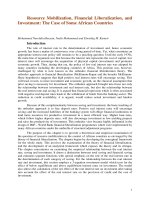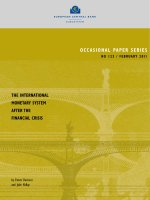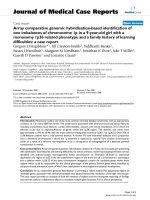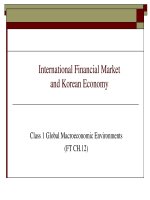International Financial Market and Korean Economy history of international monetary system
Bạn đang xem bản rút gọn của tài liệu. Xem và tải ngay bản đầy đủ của tài liệu tại đây (829.35 KB, 35 trang )
International Financial market and Korean Economy
History of International Monetary System
From “Multinational Business Finance”
by Eiteman, Stonehill, and Moffett
History of the International
Monetary System
Exhibit 1 summarizes exchange rate regimes since 1860
The Gold Standard (1876 – 1913)
Gold has been a medium of exchange since 3000 BC
“Rules of the game” were simple, each country set the rate at which
its currency unit could be converted to a weight of gold
Currency exchange rates were in effect “fixed”
Expansionary monetary policy was limited to a government’s supply
of gold
Was in effect until the outbreak of WWI when the free movement of
gold was interrupted
Exhibit 1 The Evolution of Capital Mobility
History of the International Monetary System
The Inter-War Years & WWII (1914-1944)
During this period, currencies were allowed to fluctuate over a fairly
wide range in terms of gold and each other
Increasing fluctuations in currency values became realized as
speculators sold short weak currencies
The U.S. adopted a modified gold standard in 1934
During WWII and its chaotic aftermath the U.S. dollar was the only
major trading currency that continued to be convertible
History of the International Monetary System
Bretton Woods and the International
Monetary Fund (IMF) (1944)
As WWII drew to a close, the Allied Powers met
at Bretton Woods, New Hampshire to create a
post-war international monetary system
The Bretton Woods Agreement established a U.S.
dollar based international monetary system and
created two new institutions the International
Monetary Fund (IMF) and the World Bank
Bretton Woods (1944 - 1973)
44 countries met to design a new system in 1944
Established:
International Monetary Fund (IMF) and World
Bank
IMF: maintain order in monetary system
World Bank: promote general economic development
Fixed exchange rates pegged to the US Dollar
US Dollar pegged to gold at $35 per ounce
Countries maintained their currencies ± 1% of the
fixed rate; buy/sell own currency to maintain level
History of the International Monetary System
The International Monetary Fund is a key institution in the new
international monetary system and was created to:
Help countries defend their currencies against cyclical,
seasonal, or random occurrences
Assist countries having structural trade problems if
they promise to take adequate steps to correct these
problems
Special Drawing Right (SDR) is the IMF reserve asset,
currently a weighted average of four currencies
The International Bank for Reconstruction and Development (World
Bank) helped fund post-war reconstruction and has since then
supported general economic development
The Role of the IMF
IMF maintained exchange rate
discipline
National governments had to manage inflation through
their money supply
flexibility
Provides loans to help members states with temporary
balance-of-payment deficit;
Allows time to bring down inflation
Relieves pressures to devalue
Excessive drawing from IMF funds came with IMF
supervision of monetary and fiscal policies
Allowed to 10% devaluations and more with IMF approval
187 members by 2003
The Role of the World Bank
World Bank (IBRD) role
(International Bank for Reconstruction & Development)
Refinanced post-WWII reconstruction and development
Provides low-interest long term loans to developing
economies
The International Development Agency (IDA), an arm of the
bank created in 1960
Raises funds from member states
Loans only to poorest countries
50 year repayment at 1% per year interest
History of the International Monetary System
Fixed Exchange Rates (1945-1973)
The currency arrangement negotiated at Bretton Woods
and monitored by the IMF worked fairly well during the
post-WWII era of reconstruction and growth in world
trade
However, widely diverging monetary and fiscal policies,
differential rates of inflation and various currency shocks
resulted in the system’s demise
The U.S. dollar became the main reserve currency held by
central banks, resulting in a consistent and growing
balance of payments deficit which required a heavy
capital outflow of dollars to finance these deficits and
meet the growing demand for dollars from investors and
businesses
History of the International Monetary System
Eventually, the heavy overhang of dollars held by
foreigners resulted in a lack of confidence in the ability of
the U.S. to met its commitment to convert dollars to gold
The lack of confidence forced President Richard Nixon to
suspend official purchases or sales of gold by the U.S.
Treasury on August 15, 1971
This resulted in subsequent devaluations of the dollar
Most currencies were allowed to float to levels
determined by market forces as of March 1973
History of the International Monetary System
An Eclectic Currency Arrangement (1973 – 1997)
Since March 1973, exchange rates have become
much more volatile and less predictable than they
were during the “fixed” period
There have been numerous, significant world
currency events over the past 30 years
The volatility of the U.S. dollar exchange rate
index is illustrated in Exhibit 2
Key world currency events are summarized in
Exhibit 3
Exhibit 2 The IMF’s Exchange Rate Index of
the Dollar
Exhibit 3 World
Currency Events,
1971-2011
Exhibit 3
World
Currency
Events, 19712011
(cont.)
The IMF’s Exchange Rate Regime
Classifications
Exhibit 3.4 presents the IMF’s regime classification
methodology in effect since January 2009
Category 1: Hard Pegs
Category 2: Soft Pegs
AKA fixed exchange rates, with five subcategories of classification
Category 3: Floating Arrangements
Countries that have given up their own sovereignty over monetary
policy
E.g., dollarization or currency boards
Mostly market driven, these may be free floating or floating with
occasional government intervention
Category 4: Residual
The remains of currency arrangements that don’t well fit the previous
categorizations
Exhibit 4 IMF Exchange Rate Classifications
Exhibit 4 IMF Exchange Rate Classifications
(cont.)
Fixed Versus Flexible Exchange Rates
A nation’s choice as to which currency regime to follow
reflects national priorities about all facets of the economy,
including:
inflation,
unemployment,
interest rate levels,
trade balances, and
economic growth.
The choice between fixed and flexible rates may change
over time as priorities change.
Fixed Versus Flexible Exchange Rates
Countries would prefer a fixed rate regime for the
following reasons:
stability in international prices
inherent anti-inflationary nature of fixed prices
However, a fixed rate regime has the following
problems:
Need for central banks to maintain large
quantities of hard currencies and gold to defend
the fixed rate
Fixed rates can be maintained at rates that are
inconsistent with economic fundamentals
Attributes of the “Ideal” Currency
Possesses three attributes, often referred to as the
Impossible Trinity:
Exchange rate stability
Full financial integration
Monetary independence
The forces of economics do not allow the
simultaneous achievement of all three
Exhibit 5 illustrates how pursuit of one element of
the trinity must result in giving up one of the other
elements
Exhibit 5 The Impossible Trinity
A Single Currency for Europe: The Euro
In December 1991, the members of the European
Union met at Maastricht, the Netherlands, to finalize
a treaty that changed Europe’s currency future.
This treaty set out a timetable and a plan to replace
all individual ECU currencies with a single currency
called the euro.
A Single Currency for Europe: The Euro
To prepare for the EMU, a convergence criteria was laid out
whereby each member country was responsible for managing
the following to a specific level:
Nominal inflation rates
Long-term interest rates
Fiscal deficits
Government debt
In addition, a strong central bank, called the European Central
Bank (ECB), was established in Frankfurt, Germany.
Effects of the Euro
The euro affects markets in three ways:
Cheaper transactions costs in the eurozone
Currency risks and costs related to uncertainty are
reduced
All consumers and businesses both inside and
outside the eurozone enjoy price transparency and
increased price-based competition









